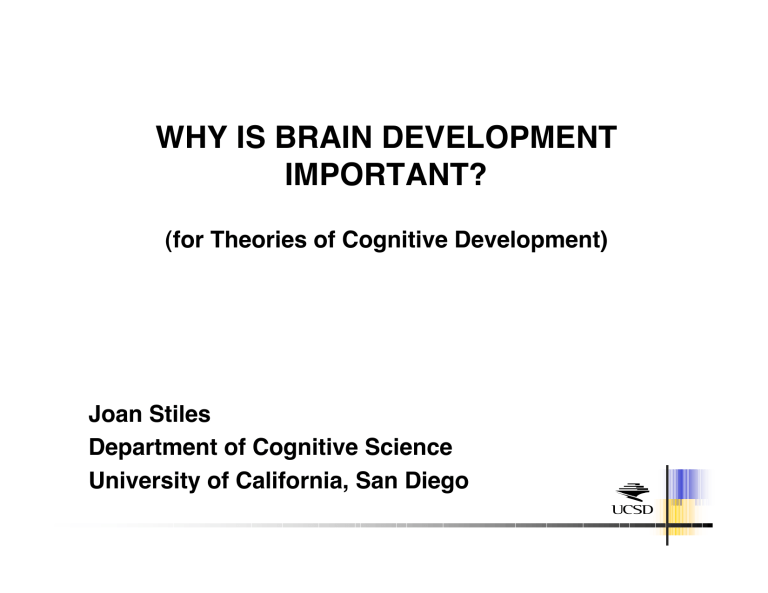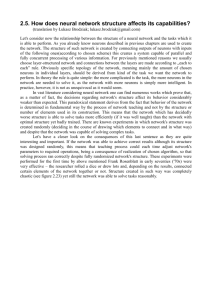WHY IS BRAIN DEVELOPMENT IMPORTANT?

WHY IS BRAIN DEVELOPMENT
IMPORTANT?
(for Theories of Cognitive Development)
Joan Stiles
Department of Cognitive Science
University of California, San Diego
COGNITIVE DEVELOPMENT
Ø How do children come to know about the world?
Ø What are the origins of knowledge?
Origins of Knowledge
Dominant psychological theories differentially stress:
(1) level and content of knowledge available to the newborn
(2) the interaction of factors and/or processes that underlie development
Origins of Knowledge
n n
Nativist approach:
Identify and define the innate conceptual constraints and structures
Provide an account of development in which basic learning mechanisms function in concert with innate cognitive structures n n
Constructivist approach:
Basic sensory, perceptual and motor abilities provide the initial early input to associative learning systems
The child constructs a knowledge system via interaction with the world.
EVIDENCE FOR INNATE ABILITIES
§ Early competence
§ Behavior manifest in the absence of experience
§ Initial modularity/ Encapsulation of function
§ Constraints on learning
“The nativist-empiricist dialogue is not about the interaction of genes and their environment but about whether knowledge of things in the world develops on the basis of encounters with those things … These questions [about the origins of knowledge] are not addressed by research on the interactions between genes and gene products, but by research on the emerging capacities of children in interaction with their surroundings.”
A CONSTRUCTIVIST VIEW
§ Cognitive structures emerge anew with each individual’s development.
§ Cognitive structures are an emergent property of the interaction of biological and experiential components.
§ Construction is a dynamic process.
“The essence of constructivism is that the relationship between the initial state and the final product can only be understood by considering the progressive construction of information …There is no simple sense in which information is either exclusively in the genes or in the environment can specify the end product.”
MISSING EVIDENCE:
BIOLOGICAL FEASIBILITY
NATIVISM: What does it mean for a concept or cognitive ability to be specified by the biological system?
EMPIRICISM: How can the experience of the organism affect brain development in a way that is relevant to the targeted behaviors ?
While necessary, psychological data alone are not sufficient to address these questions.
BIOLOGICAL FEASIBILITY
Ø While both camps focus on behavioral manifestations of cognitive abilities, their key claims rest on assumptions about the neuro-behavioral system.
Ø Knowledge of central nervous system development may well provide critical data on developmental constraints and developmental flexibility that can inform the discussion about the origins of knowledge.
Ø It may also render some classes of assumptions and claims untenable.
PREDETERMINED EPIGENESIS
Unidirectional structure-function development:
Genes ‡ Brain structure ‡ Brain function ‡ Experience
PROBABILISTIC EPIGENESIS
Multi-directional structure-function development:
Genes fl‡ Brain structure fl‡ Brain function fl‡ Experience
Gottleib, 2000
PROBABILISTIC EPIGENESIS
Multi-directional structure-function development:
Genes fl‡ Brain structure fl‡ Brain function fl‡ Experience
THIS IS WHY BRAIN DEVELOPMENT IS
IMPORTANT FOR THEORIES OF
COGNITIVE DEVELOPMENT
A FEW BRAIN FACTS
(http://faculty.washington.edu/chudler/facts.html)
Brain weight (adult human) = 1,300 gms (about 3lb)
Brain weight (newborn human) = 350 gms (about 0.8lb)
Number of Neurons = 100 billion (Cerebral Cx = 10 billion)
Total number of synapses (connections) = 60 trillion
Rate of neuron growth (early pregnancy) = 250,000/min.
PRODUCTIVE
EVENTS
The formation of the neural tube.
The generation of the major brain structures.
At a more micro level:
1. Neuron proliferation
2. Neuron migration
SUBTRACTIVE EVENTS
n
Naturally occurring cell death
n
Proliferation and subsequent retractions neural processes (axons and dentrites)
“Neurulation:”
The beginning of brain development
The development of the brain and central nervous system begins in early embryonic development:
ED 15: Formation of the “trilaminar disk” begins
ED 18: Formation of the neural plate begins
ED 27: Neural tube closes
The Development of the Neural Plate
Ø On ED 14 embryo is a two-layered structure: endoderm and ectoderm
Ø On ED 15 some of the ectoderm cells move toward the midline and begin to create a central layer ‡ as this happens the migrating cells are transformed to mesodermal cells
Ø On ED 18 embryo is a slipper-shaped structure composed of three layers: endoderm , mesoderm , ectoderm
Formation of the Trilaminar Disk
§ The ectodermal cells that will become neurons are distributed along the midline of the embryo.
§ They receive a signal from the cells in the mesodermal layer called a “neuralizing signal”.
§ The “neuralized” ectodermal cells form the neural plate .
§ This begins the developmental cascade of events that will eventually result in the formation of the Central Nervous
System (CNS).
The Development of the Neural Tube
§ Neural plate thickens.
§ Folds begin to form
§ Folds fuse in center and begin to form the tube
§ First the top and then the bottom of the neural tube close (ED 25;
ED 27)
FORMATION OF NEURAL TUBE
DEVELOPMENTAL CHANGES
IN THE PRENATAL BRAIN
STAGES OF NEURONAL
DEVELOPMENT
Ø CELL PROLIFERATION
Ø CELL MIGRATION
Ø CELL DIFFERENTIATION
PROLIFERATION
Ø Most neurons are produced in the first half of pregnancy between Embryonic Day
(ED) 42 and 125.
Ø Within a region neurons are produced before most glial cells
.
NEURONS AND GLIA ARE PRODUCED
IN THE “PROLIFERATIVE ZONE”
Ø Neurons and glial cells are formed from
Ectodermal cells.
Ø Since the closure of the neural tube, these cells now line the center of the tube in a region called the Ventricular Zone (VZ).
Ø The Ventricular Zone contains a single layer of cells that begin dividing on approximately ED 28.
CROSS-SECTION OF THE
PROLIFERATIVE ZONE
A single layer of cells. The movement of the cell nuclei gives it the appearance of stratification.
A SINGLE CELL UNDERGOING CELL
DIVISION
SYMMETRICAL AND ASYMMETRICAL CELL
DIVISION
Ø From ED 28 until ED 42 cell division is “ symmetrical ” -- each round of cell division doubles the number of cells in the
Proliferative Zone.
Ø Cells produced during this period are “progenitor” cells that are capable of generating neurons and glial cells.
Ø After day 42, “ asymetrical ”cell division begins.
Ø Some of the new cells stop dividing and migrate away from the proliferative zone – at this point they are considered neurons .
Ø Initially, the number of progenitor cells producing neurons is small, but the proportion becomes progressively greater over time.
NEURONS AND GLIA ARE PRODUCED
IN THE “PROLIFERATIVE ZONE”
Ø Cell Birthday is the day on which an individual cell stops dividing and migrates out of the
Proliferative Zone.
Ø On its birthday the cell is considered to be a
Primitive Neuron .
CELL MIGRATION
The movement of young neurons to their place in the cortex.
Migration occurs by two basic mechanisms:
§ Migration along Radial Glial Cells
§ Tangential migration
MIGRATION ALONG RADIAL GLIA
Radial glial cells form a scaffold running from the margin of the Proliferative Zone to the outer edge of the brain.
After the new neuron has it’s birthday:
§ Locates a nearby radial glial cell
§ Attaches and propels along radial glial
§ “Recognizes" final destination and detaches
§ Neurons that are produced early in development form the deep layers of cortex, cells that are produced form the surface layers
NEURON MIGRATION ALONG RADIAL GLIA
RADIAL UNIT HYPOTHESIS
Neurons produced by a small subset of neural progenitor cells migrate along common radial glial cells.
This gives rise to a highly regular correspondence between where neurons are produced and the organization of the cerebral cortex.
Rakic has theorized that the proliferative zone provides a
“protomap” of cortex
TANGENTIAL MIGRATION
Ø It has recently been found that not all cells that make up the neocortex are produced in the VZ.
Ø There a second proliferative deep in an region of the brain called the ganglionic eminence (GE).
Ø Cells produced in the GE must migrate tangentially -- across the plane of the glial fiber system.
Thus the protomap theory cannot provide a complete explanation of how the organization of cortex arises.
CELL DIFFERENTIATION
Ø Once in place neurons begin to generate axons and dendrites.
Ø They acquire enzymes necessary to produce neurotransmitters.
Ø They acquire receptors to receive synaptic transmissions.
AFFERENT
SPECIFICATION
Ø As cells begin to differentiate, they become capable of both sending and receiving information
Ø The kind of information cells in particular regions of cortex receive -- “the afferent input”
-- helps to determine what the function of that region of will be
Subtractive Events in Brain Development:
Naturally Occurring Cell Death
In the normal course of early development from 20-
80% of neurons in different regions die.
Is this:
§ part of the life cycle of the cells -- part of the cell’s genetic program?
§ an effect of factors in the local environment?
Natually Occurring Cell Death
Strong evidence that much cell death is regulated by events in the local environment.
Trophic Factors (e.g. Nerve Growth Factor): n
Present at connection sites.
n
Quantities are limited.
n
To access trophic factors, cells must make connections and those connections must be active.
n
Cells that make the best, most active connections win the competition for these limited resources.
Experimental Evidence that
Resources Affect Rate of Cell Death
Normal neuronal loss within a region ‡ 50%
EXPERIMENTAL MANIPULATION: Vary the amount of target space:
§ Surgically remove (ablate) most of target ‡ increase cell death.
§ Increase size of target region ‡ decrease cell death.
NATURALLY OCCURRING CELL DEATH
Subtractive Events: Synaptic Exuberance and Synapse Retraction
Early in development neurons form many more connections than they will have later.
The process of exuberance and pruning is very protracted: change in frontal brain regions well into adolescence
Subtractive Events :
Synaptic Exuberance and Synapse Retraction
Ø Competitive processes operate to regulate the number of connections.
Ø Activation of the neural system is crucial in determining which connections will be retained and which will be lost.
Ø Thus input to the developing neural system is critical for normal development.
EVIDENCE FOR THE ROLE OF INPUT ON THE
DEVELOPMENT OF BRAIN PATHWAYS:
“Rewired Ferrets”
From: Sur, Angelucci & Sharma, (1999) Neurobiology.
PAC
PVC
Normal patterns of projection:
Ø Retina (eyes) to primary visual cortex
(PVC)
Ø Cochlea (ears) to primary auditory cortex (PAC)
Surgical alterations:
Ø PVC surgically removed
Ø Pathway from cochlea to PAC severed
What happens to the pathways after surgery ?
PAC
PVC
!!
§ Projections from the retina make connections with primary auditory cortex (PAC).
§ Those connections in PAC fire in response to visual input.
§ It is thought that retina ‡ PAC connections occur in the normal course of development, but they typically lose the competition from cochlea ‡ PAC connections and are pruned away.
Is there evidence that this kinds of plasticity occurs in humans?
What happens if:
There is a congenital disorder that prevents all auditory input to primary auditory cortex?
Neural Reorganization in Humans following
Early Auditory Deprivation
Ø Electrophysiological studies by Neville report PAC responses to peripheral visual stimulation
Ø fMRI studies by Finney, et al report PAC responses to peripheral visual stimulation
§ Green areas indicated activation to an auditory task in hearing
§ Orange-yellow areas indicate activation to visual task in deaf
SUMMARY
Brain development is a complex and protracted process:
Ø begins at 28 days post-conception and
Ø
extends….??? Probably into adulthood
Both biology and experience play critical roles in shaping the final organization of the brain:
Ø Development is more than a simple unfolding of a predetermined genetic plan
Ø While genes are critically important for development
(abnormalities in genes can disrupt development),
Ø Brain development is also adaptive.
Ø It is the interaction of biological systems with each other and with input from the world, that ultimately determines brain organization and function






